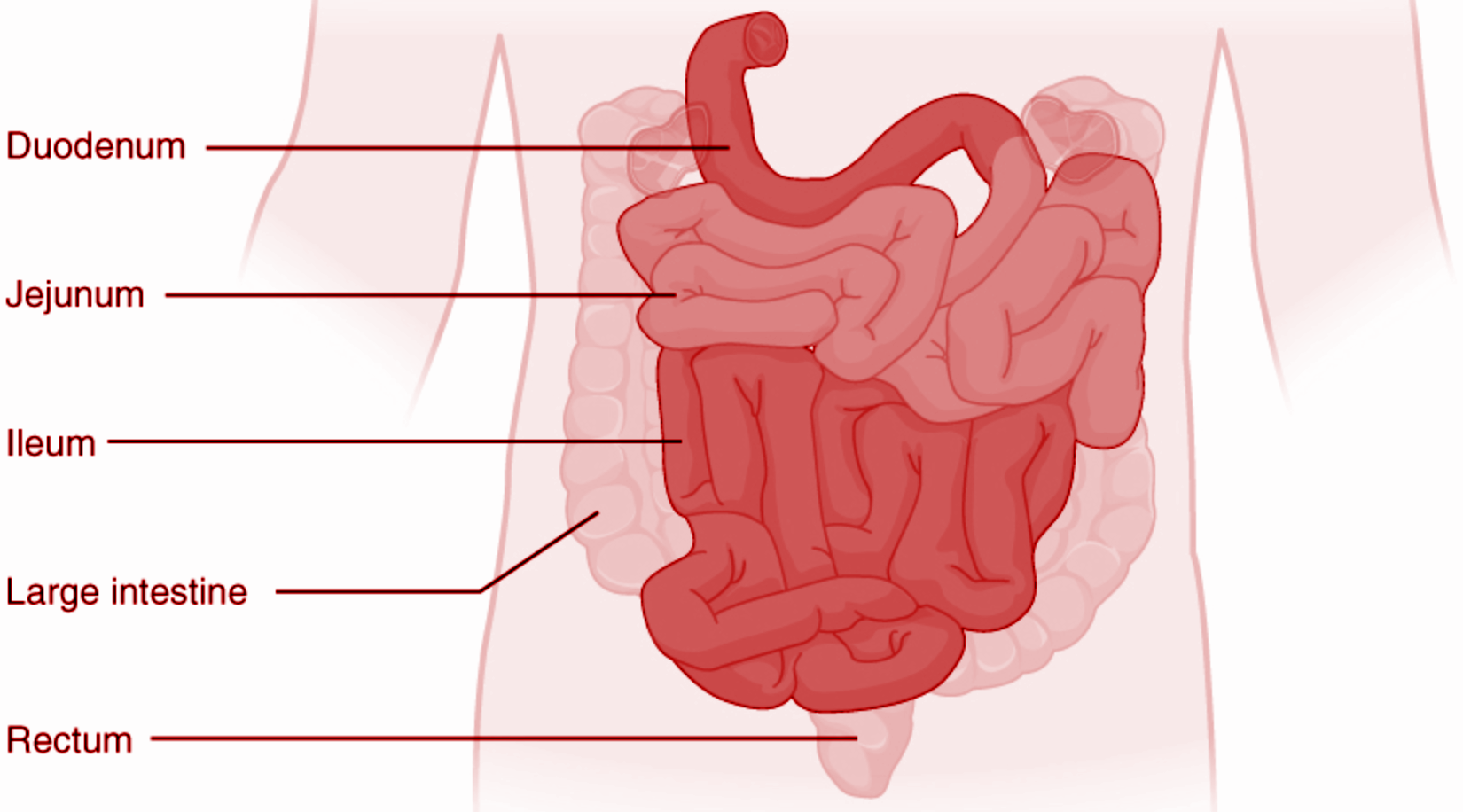
Answer
448.8k+ views
Hint: This forms the first portion of the small intestine. It is located between the stomach and the middle part of the small intestine, or jejunum. After foods mix with stomach acid, they move into this part.
Complete step by step answer:
Cholecystokinin is secreted from the duodenum of the body and causes contraction of gall bladder and secretion of the pancreatic juice into the duodenum.
Secretin is secreted from the duodenum and stimulates the secretion of pancreatic juice but inhibits the secretion of gastric juices.

So, the correct answer is 'Duodenum'.
Additional Information: The food is finally digested in the small intestine of the alimentary canal because it has all the enzymes needed for the digestion of every type of food. The intestine has a bile enzyme for the emulsification (break down) of fats. It has pancreatic lipase and intestinal lipase enzyme, which help in the final digestion of fats. It has pancreatic amylase for the digestion of carbohydrates. It has trypsinogen, which breaks trypsin under influence of enterokinase enzyme. Trypsin enzyme helps in the digestion of proteins. It has Erepsin, which again helps in the digestion of protein.
The small intestine is the longest part (6 meters) of the alimentary canal. It is a tubular part occupying the central and lower part of the abdominal cavity.
The small intestine is divided into the following parts:
1. Duodenum: It is the widest, shortest, and most flexed part of the small intestine. It is C- shape and receives bile from the pancreas.
2. Jejunum: It is the middle part of the small intestine.
3. Ileum: It is the longest part of the small intestine. Its finally open in the caecum in the lower part of the abdominal cavity.
Note:
- Cholecystokinin is secreted by cells of the upper intestine. Its secretion is stimulated by the introduction of acid, amino acids, or fatty acids into the stomach or duodenum. Cholecystokinin stimulates the gallbladder to contract and to produce stored bile into the intestine.
- Secretin has mainly three functions: regulation of gastric acid, regulation of pancreatic bicarbonate, and osmoregulation. The major physiological actions of secretion are stimulation of pancreatic fluid and bicarbonate secretion. S cells in the small intestine emit secretion.
Complete step by step answer:
Cholecystokinin is secreted from the duodenum of the body and causes contraction of gall bladder and secretion of the pancreatic juice into the duodenum.
Secretin is secreted from the duodenum and stimulates the secretion of pancreatic juice but inhibits the secretion of gastric juices.

So, the correct answer is 'Duodenum'.
Additional Information: The food is finally digested in the small intestine of the alimentary canal because it has all the enzymes needed for the digestion of every type of food. The intestine has a bile enzyme for the emulsification (break down) of fats. It has pancreatic lipase and intestinal lipase enzyme, which help in the final digestion of fats. It has pancreatic amylase for the digestion of carbohydrates. It has trypsinogen, which breaks trypsin under influence of enterokinase enzyme. Trypsin enzyme helps in the digestion of proteins. It has Erepsin, which again helps in the digestion of protein.
The small intestine is the longest part (6 meters) of the alimentary canal. It is a tubular part occupying the central and lower part of the abdominal cavity.
The small intestine is divided into the following parts:
1. Duodenum: It is the widest, shortest, and most flexed part of the small intestine. It is C- shape and receives bile from the pancreas.
2. Jejunum: It is the middle part of the small intestine.
3. Ileum: It is the longest part of the small intestine. Its finally open in the caecum in the lower part of the abdominal cavity.
Note:
- Cholecystokinin is secreted by cells of the upper intestine. Its secretion is stimulated by the introduction of acid, amino acids, or fatty acids into the stomach or duodenum. Cholecystokinin stimulates the gallbladder to contract and to produce stored bile into the intestine.
- Secretin has mainly three functions: regulation of gastric acid, regulation of pancreatic bicarbonate, and osmoregulation. The major physiological actions of secretion are stimulation of pancreatic fluid and bicarbonate secretion. S cells in the small intestine emit secretion.
Recently Updated Pages
Who among the following was the religious guru of class 7 social science CBSE

what is the correct chronological order of the following class 10 social science CBSE

Which of the following was not the actual cause for class 10 social science CBSE

Which of the following statements is not correct A class 10 social science CBSE

Which of the following leaders was not present in the class 10 social science CBSE

Garampani Sanctuary is located at A Diphu Assam B Gangtok class 10 social science CBSE

Trending doubts
Which are the Top 10 Largest Countries of the World?

In what year Guru Nanak Dev ji was born A15 April 1469 class 11 social science CBSE

A rainbow has circular shape because A The earth is class 11 physics CBSE

How do you graph the function fx 4x class 9 maths CBSE

Fill the blanks with the suitable prepositions 1 The class 9 english CBSE

In Indian rupees 1 trillion is equal to how many c class 8 maths CBSE

The Equation xxx + 2 is Satisfied when x is Equal to Class 10 Maths

Why is there a time difference of about 5 hours between class 10 social science CBSE

Difference between Prokaryotic cell and Eukaryotic class 11 biology CBSE




